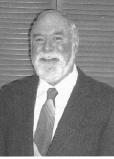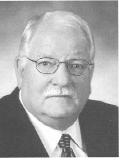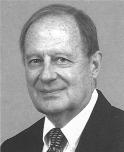2003 Honorary Life Member Selections
 DR. DENNIS CORSINI
DR. DENNIS CORSINI
It is an unfortunate fact of life that all good things must come to an end. In this case, the “good thing” that has come to an end is the distinguished career of one of Idaho’s most experienced and respected potato researchers, Dr. Dennis Corsini.
Those of us unfamiliar with Dennis’s background might be surprised to find out that this avid hunter, who enjoys horseback riding and lived out In a very rural part of Idaho, was actually born and reared in Los Angeles. After earning his BS degree in biology at UCLA, he came to the University of Idaho for a Ph.D. in plant pathology.
Dennis signed on as the plant pathologist for the USDA/ARS potato-breeding project in Aberdeen, Idaho, in 1979. While serving in that capacity, he was an integral part of the team responsible for the development of a long list of well-known potato varieties including Ranger Russet, Alturas, Umatilla Russet, Lemhi Russet, Gemchip, Bannock Russet, Gem Russet, IdaRose and others.
The breeding team’s research efforts have also resulted in the identification of lines of potato germplasm with resistance to storage rot pathogens, verticillium wilt, and blackspot bruise as well as material with virus and late blight resistance. Among other things, this germplasm is being used extensively in the national effort to breed late blight-resistant varieties.
Dennis is a plant pathologist, but his position demanded diverse skills that go well beyond the realm of pathology. Over the 28 years of his career, he has cooperated extensively with other researchers in Idaho, Washington, California, Oregon, North Dakota, and Maine in studies that utilized the germplasm developed by the ARS Potato Breeding Program at Aberdeen.
Corsini also evaluated germplasm from all the North American breeding programs in standardized disease trials and provided reports on the results. He maintained and allocated the national potato germplasm collection, working closely with Dr. Steve Love on variety development. He used state-of-the-art methods to produce and maintain healthy seed potatoes in the germplasm collection.
His professional accomplishments have been many. In addition to a long list of publications, he has served The Potato Association of America in the following capacities: Finance Committee Chair, Membership Committee Chair, Pathology Section Chair, Director, Vice-President, President-Elect, and President (1994-1995).
He has also been an affiliate professor of the Plant Pathology faculty at the University of Idaho where he served on graduate student committees and attended countless planning conferences with other research personnel.
He was honored at the 2001 National Potato Council seed seminar in Phoenix receiving the prestigious NPC Meritorious Service Award.
Dennis and his wife, Gail, have two sons, a daughter, and four grandchildren. They have retired to their new home near Sandpoint in northern Idaho. Fortunately for all of us in the industry, he has remained active in the potatoes since leaving his position in November 2002.
When asked what he thought his most important contribution to potato science was, he replied his ability to work with, communicate with, and coordinate the activities of people from all aspects of the industry, from scientists and producers to processors and politicians was his forte. He also said that his ability was what he would most wish to be remembered for. Partnered for years with Dr. Joseph Pavek, Dennis worked with Dr. Rich Novy, who replaced Joe Pavek in 2000.
Make no mistake, Dennis’s experience, his wealth of knowledge, and his clear-headed approach to problem solving will be sorely missed
 Dr. JULIAN CREIGHTON MILLER, JR.
Dr. JULIAN CREIGHTON MILLER, JR.
Creighton Miller was born in Baton Rouge, Louisiana, and his early education took place on the Louisiana State University campus at the Laboratory School/University High School. During high school he spent three summers as a pollinator for the local USDA corn-breeding program. While in college, as a liberal arts major, he worked for the LSU Entomology and Horticulture Departments and spent a summer harvesting pineapple in Hawaii.
Dr. Miller’s involvement with potatoes began when he was a youth, assisting his father, the late potato breeder, Dr. Julian C. Miller, Sr., developer of Red LaSoda and several other cultivars, and a past president of the PAA. Each fall, he would travel to Clark, South Dakota, to help harvest the LSU potato selection nursery. He went on to do a MS thesis on after-cooking darkening in potato (LSU, Horticulture). Following his Ph.D. in Horticulture (Plant Breeding) from Michigan State University in 1972, he was hired by the Texas A&M Agricultural Experiment Station at Lubbock to initiate a potato variety development program for Texas. This was not a small undertaking since there was no greenhouse, equipment, technician, storage or germplasm. In addition, there was never a critical mass of Texas potato scientists to work with.
Shortly after his arrival in Texas, Dr. Miller began working closely with Gene Shaver and Warren Trank in the development of Norgold Russet M, a line selection of Norgold Russet, which became the russet of choice for production in Texas and elsewhere. This was the beginning of his career-long interest in and appreciation of clonal selection within commercial potato cultivars, and intracultivar variation has been a focal point of his potato research. The late Dr. Robert Johansen of North Dakota State University was instrumental in assisting Dr. Miller in initiating the program by providing germplasm and generous counsel. They developed a lifelong friendship and collaboration. Ray Webb, another former student of the Sr. Dr. Miller, as well as Florian Lauer and Bob Plaisted were also helpful in the early days. Today, the Texas program is very much a cooperative effort, involving the programs at Colorado State University, North Dakota State University, USDA/ARS at Aberdeen and Beltsville, and the University of Minnesota breeding programs, in addition to the Western Region Cooperators. Potato breeding research in Texas requires extensive travel, as the South Texas plots planted in early December are 350 miles from College Station, the Springlake plots, planted in mid-March, are 550 miles away and the Dalhart plots, planted in mid-May to mid-June, are 750 miles away.
In 1975, Dr. Miller was offered the opportunity to assume a teaching/research position (cowpeas) at the main campus in College Station. He accepted the position, assured that he would continue the potato-breeding program and that haft of the salary from his former position would be used to hire a technician at Lubbock for the program. In 1980, he was asked to serve as Interim Head of the Department of Horticultural Sciences. He held this position for three years, with many accomplishments, such as organizing the department’s first promotion and tenure committee, initiating exit interviews for graduating seniors, providing leadership for obtaining nine new faculty positions statewide, and with others revamped the Texas A&M undergraduate horticulture program which, shortly after, was ranked second nationally by the Gorman report, a position it still holds today.
Dr. Miller has taught six different undergraduate and graduate courses, which have included over 3,000 students. He was the 1992 recipient of the prestigious L.M. Ware Distinguished Teaching Award from the Southern Region ASHS. He has served as major professor for 19 M.S. and 15 Ph.D. students, and on the graduate advisory committees of over 150. Eleven of his former students have received regional or national recognition for their research paper presentations, including two first place awards in the PAA Graduate Student Paper Competition. Two have received the National Potato Council Auxiliary Scholarship, presented to students pursuing graduate degrees in potato research.
Dr. Miller has been an active participant and served in leadership roles in the Inter-Regional Potato Introduction Project (NRSP-6), the Western Regional Potato Variety Development Coordinating Committee (WRC-27), the Potato Crop Germplasm Committee, and more recently, the Southwestern Regional Potato Variety Development Project. He holds membership in the National Potato Council. Additionally, Dr. Miller, has served as President of the Southern Region, American Society for Horticultural Science (ASHS), and as ASHS national Research Division Vice-President. He is an ASHS Fellow and received their Outstanding Vegetable Publication Award in t987. He is a member of Alpha Zeta, Gamma Sigma Delta, Phi Sigma, Sigma Xi, and Phi Kappa Phi. He has authored/co-authored more than 250 scientific publications, including 43 refereed journal articles.
Dr. Miller served in the U.S. Coast Guard. He has been a US Swimming official for more than 25 years and is a certified collegiate swimming official for the Big XII and national meets. He is past president of the Bryan-College Station Swim Club. He has taught 6th grade Sunday school, chaired the Stewardship and Finance Committees, and serves as an Elder for the First Presbyterian Church, Bryan, Texas.
Dr. Miller has been a member of the Potato Association of America since 1965, when he initiated his M.S. program. He has been an active member of the Breeding and Genetics Section and a participant in activities of the Physiology and Pathology Sections. He chaired the Graduate Student Outstanding Paper Committee for three years. Dr. Miller served as a PAA Director 1995-1996 and Vice-President 1996-1997. As President-elect and President, Dr. Miller provided exceptional leadership to the PAA, chairing the committee recommending the name change from the American Potato Journal to the American Journal of Potato Research. Along with graduate student Anna Hale, he developed a comprehensive web site for the PAA During his presidency (1998-1999), several important initiatives were undertaken, including creation of the PAA Endowment Fund, strengthened ties with sister organizations (NPC, NPPB, EAPR and ASHS), established and provided active leadership on the PAA 2000 Committee, which developed a vision statement for the Association as it entered the 21st century, and many others.
Dr. Miller established a successful potato breeding program for Texas and has developed or co-developed 11 potato cultivars – Norgold Russet M (in collaboration with Gene Shaver, Warren Trank, and Gary Leever), Krantz (with Florian Lauer), Russet Nugget (with David Holm), Century Russet (with Western Regional Cooperators), Stampede Russet (with Dermot Lynch), Cherry Red (with David Holm), Russet Norkotah 112, 223, 278 and 296, and, most recently Sierra Gold TM (TX1523-1Ru/Y). Virtually all of the russet acreage in Texas is grown to one or more of his Texas Russet Norkotah strains. When Dr. Miller initiated the Texas program, average yields for the summer crop were about 175 cwt/acre; they now average 400 cwt/acre, the highest summer-crop yield in the nation.
He has been married to Dr. Jeanie Miller, also a Professor at Texas A&M, for 38 years. They have a son and daughter. Creighton III is a vice-president with Washington Mutual, Seattle, and has two daughters. Jennifer is married and is a registered dietitian and senior pharmaceutical sales representative with Mead-Johnson, Dallas.
 Dr. D. P. “PETE” WEINGARTNER
Dr. D. P. “PETE” WEINGARTNER
Pete Weingartner grew up in Michigan’s Upper Peninsula. He graduated from Gladstone High School in 1957 and earned degrees at the University of Michigan and Michigan State University. Dr. Weingartner joined the faculty at the University of Florida, IFAS, Hastings Research and Education Center (then known as the Potato Investigations Laboratory) in May 1969 and served as pathologist/nematologist at the center until its closure in April 2002. He is presently a professor in the UF/IFAS Plant Pathology Department at Gainesville.
Dr. Weingartner developed an extensive research and extension program in potato disease and nematode management. His research emphasized both foliar and soil-borne diseases of potato and included studies on nematodes, corky ringspot, bacterial wilt/brown rot, early dying, early and late blight. Through collaborations with UF/IFAS colleagues, USDA scientists, and others, a truly integrated nematode and soil-borne pathogen management program, encompassing the use of nematicides, cultivar resistance, and em4ronmental conditions, was developed for north Florida potatoes. Average potato yields in the Hastings, FL, area increased by nearly 30% following adoption of these practices by the industry. The Society of Nematologists, Florida Fruit and Vegetable Association and Florida State Horticultural Society recognized Dr. Weingartner and his colleagues for publications related to this work.
Pete also had active research projects on both potato early and late blight diseases. He developed and field-tested Florida Blitecast, for forecasting blight in the Hastings area. Despite introduction of new strains of blight the system remains reliable for synoptically scheduling initial late blight fungicide sprays. Dr. Weingartner has done extensive field evaluations of late blight resistance in cooperation with Dr. Kathy Haynes and has investigated efficacy of dozens of new fungicide programs for blight control. During 1993 – 2002 he monitored and catalogued genotypes of P. infestans from potato and tomato fields throughout Florida. Dr. Weingartner has published his research in over 300 publications including 11 book chapters and 40 refereed papers and was recently a coeditor of the 2nd edition of the Potato Disease Compendium.
Pete has been active in the PAA since 1973. He has served on numerous PAA committees including Finance, Strategic Planning, Site selection, and others. He was LAC and Symposium chair for the 2001 Florida PAA meetings. He has held all PAA offices and served as President in 1996 -1997. He has also has participated in other potato groups including the NPC Seed Potato Seminar and the Snack Food Association meetings both as an attendee and speaker. He organized and secured funding for the late blight workshop held in conjunction with the 1993 Seed Seminar.
Dr. Weingartner has been active in his St. Augustine, FL, community including serving seven years on the St. Johns County School Advisory Committee and 16 years on the County School Board. He has been a frequent science fair mentor and judge. He serves on his church Finance Committee and is a regular cook at church functions. His hobbies include cooking, fishing, and gardening. Pete has been married for 39 years to his supportive wife Sharon. The Weingartner’s have two daughters Kris (McManama) and Lorin (McDade) and three grandbabies…Kayla, Cole, and Megan .